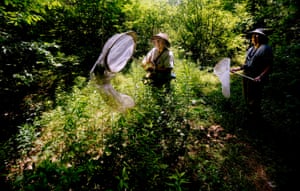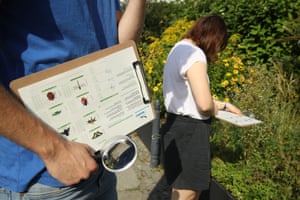With thanks to Gordon Edwards:
Comment:
Industry loves the concept that pollution can be “sold” as a benefit to people.
In particular, claiming that chronic radioactive pollution left over from nuclear disasters or from atomic warfare is not ultimately harmful, makes both the spread of nuclear power worldwide and the potential for “limited” nuclear warfare just a bit more attractive to elected representatives and to military leaders.
Below is a good article that briefly summarizes the current situation and the history that led up to it.
Gordon Edwards.
– – – – – – – – – – – – – –
Scientist says some pollution is good for you
– a disputed claim Trump’s EPA has embraced
by Suzanne Rust, Los Angeles Times
https://www.latimes.com/local/california/la-me-secret-science-20190219-story.html
In early 2018, a deputy assistant administrator in the EPA, Clint Woods, reached out to a Massachusetts toxicologist best known for pushing a public health standard suggesting that low levels of toxic chemicals and radiation are good for people.
“I wanted to check to see if you might have some time in the next couple of days for a quick call to discuss a couple items …,” Woods wrote to Ed Calabrese.
Less than two weeks later, Calabrese’s suggestions on how the EPA should assess toxic chemicals and radiation were introduced, nearly word for word, in the U.S. government’s official journal, the Federal Register.
“This is a major big time victory,” Calabrese wrote in an email to Steve Milloy, a former coal and tobacco lobbyist who runs a website, junkscience.com, that seeks to discredit mainstream climate science.
“Yes. It is YUGE!” wrote Milloy, in response.
It was a glorious moment for Calabrese, who had been snubbed for decades by mainstream public health scientists because of his controversial research and theories.
It also signified the major shift the EPA has taken under the Trump administration. More than any before it, this White House has actively sought out advice from industry lobbyists and the scientists they commission in setting pollution rules
Denouncing the Obama-era EPA as an agency beholden to environmental extremists, the administration has not only dismissed mainstream science but embraced widely discredited alternatives that critics say are not consistent with the agency’s focus on improving public and environmental health.
Calabrese’s role illustrates a different side of this shift: the potential removal of longstanding public health practices and the incorporation of industry-backed and disputed science into federal environmental policy.
Calabrese spent decades advancing his ideas, facing skepticism and criticism from peers in the toxicology community while winning funding from companies whose bottom lines conformed with his views.
He says most of the pushback he receives comes from left-of-center toxicologists who see him as “the devil incarnate” for accepting industry funding and challenging their ideology. He maintains his science is solid and will be vindicated in time.
“These environmental regulatory people are very closed-minded,” he said. They won’t reconsider their standards, and see that some of the agents they call harmful “actually can induce adaptive responses,” Calabrese said.
This view — that pollution and radiation can be beneficial — has many experts worried. The fact that such a position may become EPA policy, they say, portends a future in which corporate desires outweigh public and environmental health.
“Industry has been pushing for this for a long time,” said David Michaels, former assistant secretary of labor for the Occupational Safety and Health Administration who’s a professor of environmental and occupational health at George Washington University. “Not just the chemical industry, but the radiation and tobacco industries too.”
If the EPA ultimately adopts Calabrese’s proposed new regulations, researchers say it could change decades of standards and guidelines on clean air, water and toxic waste. It could also fundamentally alter the way the government assesses new chemicals and pesticides entering the marketplace.
“This is industry’s holy grail,” said Michaels.
Can pollution be healthy?
For decades, federal agencies charged with investigating and regulating carcinogens, toxic chemicals and radiation have been guided by the assumption that if a substance is dangerous at some level, it is harmful at any level. The higher the exposure, the more harm done. The lower the dose, the less. And the risk doesn’t entirely disappear until the substance is removed.
This is known as the linear no-threshold model, and industry dislikes it because it generally assumes that there is no level, or threshold, of exposure that can be considered totally safe.
But research done on low exposures to toxins has been less than definitive. Experiments designed to test carcinogens and radiation at low levels often produce conflicting results — with, for example, some studies of a chemical showing harm, other studies showing no effect, and a few suggesting a net benefit. In other cases, there is no information at all to guide regulators.
In the face of such uncertainty, the EPA and other agencies have taken a cautious approach by relying on the linear no-threshold model. Where data are absent or uncertain, they assume some level of risk.
It is an imperfect but protective approach, say many public health specialists. They argue that in a human population that varies widely in age, health and levels of chemical exposures, it is imperative that the agency cast a wide, conservative and protective net.
For decades, national and international scientific bodies have upheld this approach. It has been reviewed and re-reviewed dozens of times, including most recently by the congressionally chartered National Council on Radiation Protection and Measurements, the National Academy of Sciences, Engineering and Medicine and the EPA.
At the same time, industry has funded scientists to conduct and promote research designed to poke holes in the linear no-threshold model.
And that is where Calabrese comes in. He has long argued that regulators “erred on the side of being protective” at the cost of billions of dollars per year to industry.
Calabrese is a proselytizer of hormesis, the idea that dangerous chemicals and radiation are beneficial at low doses. He says they have a stimulating effect.
“It’s clearly not mainstream,” said Thomas Burke, professor and director of the Risk Sciences Institute at Johns Hopkins’ Bloomberg School of Public Health.
Burke and other experts say there are clearly scenarios where toxic chemicals can have beneficial effects in clinical and pharmacological settings, such as in the case of tamoxifen, which at low doses is effective at preventing and treating breast cancer but at higher doses can lead to blood clots, stroke and uterine cancer.
But, they say, what happens in a clinical setting can’t and shouldn’t be immediately applied to a regulatory, public health setting.
In the clinical case, “you have a doctor controlling and administering the medication to an individual,” said David Jacobs, a professor of public health at the University of Minnesota, who has published studies showing hormetic effects in some industrial pollutants. “The doctor can pull the medication at any time.”
“There is no way to control the dose a person gets from an industrial or agricultural chemical,” he said. “It’s not being doled out in pills and monitored by a physician who can lower it if the patient isn’t responding well.”
Therefore, Jacobs said, it would be dangerous to use hormesis as a framework for protecting public and environmental health.
“It really doesn’t pass the sniff test” when applying it to public health, Burke said, while allowing for its place in the forum of ideas. “I always teach my classes that there are other theories. It’s like any part of science, there are different points of view. Whether it’s about climate change or low doses.”
But he also teaches that one needs to know who has skin in the game. And in the case of hormesis, he said, that’s industry.
Big Tobacco embraces disputed research
In the early 1980s, Calabrese was a tenured professor at the University of Massachusetts, stringing together public agency and industry-funded grants to study chemicals in drinking water and the effects of ozone on mice.
His funders included the EPA, the state of Massachusetts, the Hoffman-LaRoche pharmaceutical company and semiconductor giant Digital Corp.
Then in 1985, he reached out to the Council for Tobacco Research, the research arm of the tobacco industry, seeking a grant to examine “a possible inherited and metabolic susceptibility to lung cancer in smokers.” His proposal was declined.
Sheldon Sommers, a physician at New York’s Lenox Hill Hospital and scientific director of the council, wrote in response to the grant application that Calabrese’s proposal “… is a mad hatter’s tea party sort of epidemiologic approach, and a total $2.1 million plus would likely be frittered away in my opinion,” according to documents from the UC San Francisco Truth Tobacco Industry Documents archive.
But by the 1990s, Calabrese had solidly established himself as a trusted scientist with the tobacco industry. He found they were interested in research that questioned the methods that regulatory agencies use to assess risk.
In a 1994 proposal to R.J. Reynolds, Calabrese offered to investigate a new kind of smokeless cigarette for the company, but also incorporate into his research “the loss of current benefits associated with smoking, such as protection from certain types of cancers and other illnesses…”
It was when he began his work on hormesis that Calabrese got attention from a broader range of industries.
With seed money from R.J. Reynolds, Dow Chemical, Procter & Gamble and others, as well as the EPA, Calabrese established a hormesis working group at the University of Massachusetts, which he called the Biological Effects of Low Level Exposures, or BELLE. Minutes from a 1990 advisory board meeting show the group chose not to use the word “hormesis” in its official name.
According to documents, Calabrese and his funders also held off on pushing a hormesis regulatory agenda until they’d built a sizable base of published scientific research.
Between 1990 and 2013, Calabrese received more than $8 million from companies and institutions, including R.J. Reynolds, Exxon Mobil, Dow Chemical, General Electric, the Department of Energy and the U.S. Air Force, to conduct research on hormesis.
Spokesmen from Exxon Mobil and the Air Force say they no longer fund Calabrese’s work.
Calabrese established his own scientific society, the International Dose Response Society, and his own hormesis journal — now called Dose Response — where he served as editor-in-chief.
He wrote hundreds of articles, in his own journal and in others (including “Should hormesis be the default model in risk assessment?” and “The importance of hormesis to public health”), organized dozens of conferences and delivered scores of talks.
And while his publication portfolio is vast, it is also broad. It includes not just studies of hormesis, but research on soil ingestion, opinion pieces on law and regulatory policy, historical treatise on science, and a few scathing, posthumous rebukes of revered scientists, such as Herman Muller, a Nobel prize-winner and supporter of linear no-threshold.
Calabrese insists his funding does not influence his work.
“My job involves finding financial support to do studies in my field,” said Calabrese. “I seek support from the private and public sectors. The University independently evaluates each of these for compliance with the rules.”
Not all of his money comes from industry or government agencies with extensive toxic waste sites. Between 2000 and 2013, Calabrese received $50,000 from the EPA to hold a conference on soil ingestion, and $50,000 from CalEPA for a reference database he built on cancer publications. He also received a $750,000 joint grant from the EPA and the American Chemistry Council, the chemical industry’s trade group, to study soil ingestion by construction workers.
Yet, despite his prolific career, he has instigated criticism and rebuke from many of his peers for his push on public and environmental health policy. He has been described as a “prominent industry consultant,” having “outlying views,” whose science is “way out there.”
For years he failed to get regulatory agencies to take him seriously.
Then Donald Trump was elected president.
‘We are winning’
On Sept. 5, 2017, nearly nine months after Trump was sworn in as president and seven months after Scott Pruitt was confirmed as head of the EPA, Calabrese wrote an email to Milloy, the former coal lobbyist who is a Fox news commentator. The Los Angeles Times obtained the emails through a public records request to the University of Massachusetts.
“I wanted to connect with you on whether and how it may be possible to get the EPA to consider changing the LNT [linear no-threshold model] to something far better,” Calabrese wrote.
Milloy had served on Trump’s EPA transition team and was still in touch with high-ranking officials in Pruitt’s agency.
A few months later, Calabrese wrote to Milloy again, letting him know that he’d corresponded with Ryan Jackson, Pruitt’s chief of staff, and sensed interest in a move against linear no-threshold.
Not long after Woods, the EPA’s deputy assistant of the Office of Air and Radiation, emailed Calabrese asking if he wanted to talk about “default linear assumptions” and other items.
The two arranged a call, and on April 19, 2018, Woods sent Calabrese draft language for a small section in the EPA’s proposed new ruling on transparency, called “Strengthening Transparency in Regulatory Science.”
“It is good what you have but you need a little more,” wrote Calabrese, who then suggested a line, which he altered twice, in email exchanges with Woods, before settling on this: “EPA shall also incorporate the concept of model uncertainty when needed as a default to optimize low dose risk estimation based on the major competing models (LNT, Threshold, and Hormesis).”
In other words, if the EPA is uncertain about a particular chemical’s impacts at low doses, it would abandon linear no-threshold as a default, and try other models instead, including hormesis.
On April 25, Milloy sent Calabrese the final wording for the draft proposal, which included Calabrese’s line nearly word for word.
“I am almost passing out with surprise and euphoria… ” Calabrese wrote Milloy after seeing the document.
The rule was posted for comment in the Federal Register on April 30, although a final ruling has not been announced.
John Konkus, an EPA spokesman, said the input and perspective from “the Editor-in-Chief of the journal, Dose Response” was welcomed, and reflected the perspective of “a wide variety of scientific experts” the agency reached out to when drafting the proposal.
Public health specialists outside the agency say that if the final language is adopted, it is likely to tie the EPA up in knots as it tries and then debates all the alternative models. It could also have profound effects on current and future standards for drinking water, air and toxic waste sites.
“EPA tries to be conservative in its setting of risks,” said Jan Beyea, a retired radiation physicist who has worked with the National Academies of Science. “Calabrese and collaborators think that most pollutants are good for you at low doses, so no need to be conservative.”
EPA spokeswoman Molly Block declined to speculate on whether the rule would be passed and how it would affect environmental rules that were set based on the linear no-threshold model.
Industry groups have praised the proposed change.
“We support moving away from over-reliance on the linear no -threshold default,” wrote a spokesman for the American Chemistry Council, the trade group for the chemical industry. It’s a method, he says that “frequently results in inflated health risk estimates and unwarranted, costly risk management decisions.”
Milloy also seemed pleased with the proposed ruling.
“The EPA should be open and transparent about how and what they are basing their decisions on,” he said, “and they should be using the best science available.”
In any case, he said, “we’re winning.”







